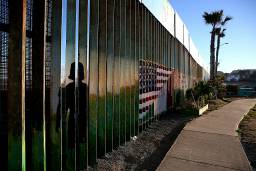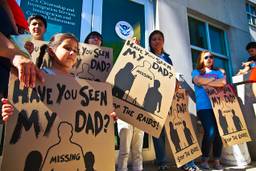The U.S. Is Locking Up Immigrant Children in Private Prisons Under Inhumane Conditions
The message being sent by the U.S. government is that when frightened women and children come to America seeking sanctuary, we will imprison them
John Washington

Drive south from San Antonio across the flat, derrick-studded, orange-dirt plains of South Texas, veer off Interstate 35 into the tiny fracking boomtown of Dilley, park in a gravel lot, get buzzed in, and you have arrived at the complex of trailers that comprise the South Texas Family Residential Center. This is the largest of three facilities where the U.S. government locks up immigrant women and children who are picked up — or request asylum — at the U.S.-Mexico border. ACLU lawyer Carl Takei describes the place as an internment camp. I’ve also heard it variously described as a “baby jail,” “worse than a Syrian refugee camp,” a “prison camp,” a “concentration camp,” and, what it most feels like: a grand, inhumane, discriminatory “shitshow.”
Mostly, though, the center is just referred to as “Dilley,” as I learned in my week as a volunteer there with CARA Family Detention Pro Bono Project, a legal-aid clinic. Dilley is privately run by the for-profit prison contractor Corrections Corporation of America (CCA). Inside, after you pass through security, you will find women and children confined, humiliated and denied due process by the U.S. government and its private, predatory henchman, CCA.
By any other name
CCA’s website advertises the detention center as providing “care with dignity and respect.” But no matter how much window dressing CCA and Immigrations and Customs Enforcement (ICE) put on Dilley, they are “using a prison model to detain 2,000 women and children,” says Brian Hoffman, lead attorney at CARA. Inmates can’t leave and are closely watched by guards. They are subject to multiple headcounts during the day and bed checks at night, and afforded little privacy.
Opened in December 2014 and still expanding to its full capacity of 2,400, Dilley is part of the explosion in family detention, which has expanded thirtyfold over the last year, from fewer than 100 beds to nearly 3,000, according to Human Rights Watch. Facing heat last summer about the thousands of Central American children arriving at the U.S.-Mexico border, the Obama administration announced a “solution” that drew condemnation from many human-rights groups: It would open new facilities to detain families caught crossing the border and massage immigration policies to ramp up deportations of Central American migrants. Many of these women and children are fleeing violence, and have legitimate claims for asylum. But the new policies also introduced tougher screening for asylum-seekers, who are often stuck in family detention centers for months before their cases are heard. According to Crystal Williams, executive director of the American Immigration Lawyers Association (AILA) — one of the groups running CARA — one month is the minimum stay at Dilley, two-and-a-half months is standard, and four to five months is typical in complicated cases.
To fight deportation and be considered for asylum, women and children must first prove they have “reasonable or credible fear” of returning to their home countries. If they pass this hurdle, they are eligible to bond out while they await their final asylum hearing — a process that can take months or even years. But bond prices in the family detention centers can be prohibitively high. In the now-closed Artesia Detention Center in New Mexico, the mean bond price was $17,000. Bonds at Dilley are sometimes as low as the legal minimum of $1,500, but are often between $4,000 and $8,000, and occasionally as high as $12,000, according to Williams.
Though school-age kids attend classes inside Dilley and have almost constant access to milk and apples, the atmosphere is punitive. Many of the children have colds or coughs. Medical attention is slow and, according to two of the women I interviewed, some sick kids are told by medical staff simply to drink water. This is the same tap water that the cook at a local drive-thru taco shop told me not to drink “ ’cause of the oil.” Residents are concerned about fracking wastewater contaminating their groundwater.
Many of the kids have trouble sleeping, and three of the women I spoke with reported that their children were depressed and not eating. One told me that her 11-year-old boy lost more than 10 pounds since coming to Dilley. “We are creating a mental health crisis,” Hoffman says. “These kids are going to have PTSD and need serious therapy.”
The long waits and tense conditions take their toll on the women, too. Despite the nearly round-the-clock efforts of CARA’s legal team, some women in Dilley lose their chance at legal status in the United States because they can no longer suffer being locked up. I spoke with one woman who had been in Dilley five months and, unable to handle it anymore, decided to be deported. The conditions at another family detention center, in Karnes, Texas, drove a 19-year-old woman to cut her wrists on June 4. She had a 4-year-old son with her and wrote in a suicide note that the detention center was “killing me little by little” and that she was “treated worse than an animal.” She survived and, four days later, was deported to Honduras.
Another woman said that she was humiliated when a Dilley guard immediately washed his hand after her toddler daughter touched it. “They think we have diseases,” she told me, breaking into sobs.
One girl I met begged her mother to agree to deportation because she didn’t want to have her ninth birthday in prison. What she wanted was ice cream, which is not available inside Dilley. Another girl, having been held for the past 10 months in family detention centers in Artesia, Karnes and now Dilley, included an ICE officer in a picture she drew of her family.
A hellish journey
For these women and children, the ordeal at the hands of the U.S. government begins long before Dilley, with the immigration policies that leave them few options besides the dangerous overland journey from Central America to the United States. Many pay “coyotes” $7,000 or $8,000 to lead them across a country, Mexico, that Salvadoran writer Óscar Martinez describes as an “inferno” for undocumented migrants. As Joseph Sorrentino reported in the May issue of In These Times, an estimated 60 percent of women migrating through Mexico are raped, and as many as 20,000 migrants are kidnapped each year.
Yet there is no other viable recourse for those fleeing the gang and drug violence epidemic in Guatemala, Honduras and El Salvador. Some try to apply for U.S. refugee visas in their home countries, but ceilings are absurdly low: In September 2014, President Obama set a ceiling of 70,000 on the number of political refugees that could be resettled in the United States over the next year, only 4,000 of which were allocated to Latin America and the Caribbean. The previous year, nearly 240,000 Central American migrants were apprehended along the U.S.-Mexico border. The common — and fatuous — “get in line” argument for immigrants to follow the proper legal channels proves dubious when those channels are blocked for most.
In Dilley, I spoke with a woman, Pabla (a pseudonym), who left El Salvador with her 13-year old son, Jorge (also a pseudonym), because gang members in one of the most murderous places in the world had begun trying to recruit him. After paying $7,000 for the trip from El Salvador to Texas, they were kidnapped by the brutal drug cartel Los Zetas in the Mexican border city of Reynosa and held for six days until Pabla’s sister-in-law in the United States could send $3,000 in ransom to save their lives. When I asked Jorge about the kidnapping, he shrugged his bony, narrow shoulders, not wanting to talk about it.
After being released, the pair crossed the Rio Grande in a raft and turned themselves in to the Border Patrol, explaining that they were scared for their lives in El Salvador and were seeking asylum. Next, they spent three days in the overcrowded, freezing-cold Border Patrol holding cells known as hieleras, or ice boxes. Inside the hieleras they were given little to eat and nothing to sit or sleep on but an aluminum blanket. Jorge got sick. In the days that followed, mother and son were transfered three times, and some of their paperwork and belongings were lost, including a slip of paper with all the phone numbers of their family members. Finally, they were shipped to Dilley, where they were stuffed into a “cabin” with 10 strangers, afforded no privacy and told when to go to sleep and when to wake up.
Pabla broke into tears in front of me and a fellow volunteer — two strangers — as we tried to help her find a phone number for a family member who could post her and her son’s $5,000 bond. If they come up with that money, their trip will have cost them a total of $15,000 dollars to date: $7,000 to a coyote, $3,000 to Los Zetas and $5,000 to the U.S. government. In El Salvador, median monthly incomes are $661 for urban households and $362 for rural households. Though the bonds are often refundable, it can take years.
Another woman told me she’d gone hungry for days in the hielera, receiving only a few white bread and ham sandwiches each day. She was so traumatized by the experience that she had trouble swallowing food in Dilley and would occasionally break into tears when she smelled meat.
From the standpoint of these women and children, what’s the difference between the U.S. government, coyotes and Los Zetas? Each captures frightened women and children fleeing violence and holds them against their will for thousands of dollars.
Execs from CCA, GEO Group and the other for-profit corporations involved in family and immigration detention also get their cut. CCA charges the government an estimated $296 dollars a day for each detained woman or child, according to the New York Times. At a capacity of 2,400, that will amount to over $250 million a year to lock up non-criminals: Your tax dollars paying for months of child incarceration.
Also, because of ICE’s inefficiency, there are some women who “are languishing back there whose bond has been paid,” Hoffman told me. For every four days that one of these women remains stuck in prison because of bureaucratic logjamming, CCA makes another thousand bucks. (Neither ICE nor CCA responded to requests for comment on this article.)
Denied due process
Unlike criminal defendants, immigrants fighting deportation, including asylum-seekers, are not guaranteed counsel in court. Even if they were, the remote location of many of the immigration detention centers make it exceedingly difficult to find representation. And although those seeking asylum from inside Dilley are entitled to a hearing even without counsel, often no one bothers to explain that to them. “A lot of these women,” Hoffman tells me, “believe they will never see a judge unless their deportation officer decides to let them.”
Twice in my week at Dilley, I witnessed the arbitrary meting of justice to asyum seekers. In the first case, I sat with a woman, Carolina (a pseudonym), for her Credible Fear Interview (CFI), the proceeding in which an Asylum Officer (AO) assesses a client’s credible fear and potential eligibility for asylum. I had twice met with Carolina, as well as her 2-year-old daughter, Elisa (also a pseudonym), to help Carolina hash out her story and clarify her claim.
Carolina had lived and worked with a circus troupe since she was a girl, traveling throughout Honduras to give performances. Rival gangs Mara Salvatrucha (MS-13) and Mara 18 both took advantage of the troupe, extorting them and using them to hide fugitive members under threat of death. Once, when Carolina refused to perform in order to distract police from fugitive gang members, an MS-13 member stabbed her twice in the leg. Another MS-13 member repeatedly robbed her, threatening to kill both Carolina and her daughter if she didn’t give him money or if she went to the police.
For Carolina’s CFI, the AO used a phone-in interpretation service. Carolina, the AO and I sat in an antiseptic office in one of Dilley’s trailers. At first, Carolina had trouble hearing the interpreter. Then the interpreter had trouble hearing Carolina. In the playroom, heard through the thin trailer wall, a child started crying. Throughout the interview, the interpreter repeatedly misunderstood Carolina. I tried to correct the translation, but the AO officer wouldn’t let me speak. The AO missed the most important thread of Carolina’s story — that of being intimidated by the rival gangs, the fear she most often described to me.
Reduced to passive observation for over two hours, I was given a chance to make a closing statement at the end of the interview, in which, shuffling rapidly through 10 pages of notes, I corrected a number of translation mistakes, and then attempted to encapsulate a life of fear and hopelessness in a few minutes on behalf a woman I had met the previous day and who was from a country I have never been to — not to mention the fact that I’m not a lawyer and hadn’t heard of a CFI until about a week before. Toward the end of the interview, Carolina was reduced to tears as the frustrated AO resorted to a blatantly patronizing tone when Carolina tried to repeat part of her story. The AO then apologized — to me, in English — that she didn’t have any tissues. Weeks later, the AO officer denied Carolina’s claim of credible fear. With the help of CARA volunteers, she appealed the ruling on June 19, but was denied again.
I also sat in on a tele-hearing in which an indigenous Mam speaker from Guatemala appeared before a flat screen television to appeal an AO’s decision that she did not have credible fear of persecution. In Miami, the judge held court in front of a camera and a screen of her own. She had a Spanish interpreter in the courtroom and a Mam interpreter on a telephone loudspeaker. The questions to the client went from Judge (in Miami) to Spanish Interpreter (Miami) to Mam interpreter (undisclosed location) to client (Dilley) back to Mam Interpreter (undisclosed location) to Spanish interpreter (Miami) back to judge (Miami). That is: English to Spanish to Mam to Mam to Spanish to English, in three locations. Not surprisingly, it was a total bungle, but this time with a positive result for the woman. The judge, obviously frustrated, vacated the asylum officer’s decision, allowing the woman’s asylum plea to move forward.
In a blog post, Laura Lichter, former president of AILA, described the life-and-death stakes of representation in these cases:
Statistics show that the most important factors in an asylum claim are whether an applicant has legal help. … Losing asylum doesn’t just mean that someone won’t have an opportunity for the American dream. In these cases, the difference between winning and deportation is the difference between life and death. Just because the facility plans to offer Zumba classes and is putting in sod for a soccer field doesn’t make Dilley any less of a deportation mill.
Dilley Kids
The women and children in Dilley could go on to win their cases. Eighty-eight percent of those in family detention centers have been found to have a credible fear of persecution.
But that means this mass detention of asylum seekers is simply a cruel and insolent political gambit. When Dilley opened in December 2014, Department of Homeland Security (DHS) Secretary Jeh Johnson asserted that the facility would serve as “an effective deterrent” to further immigration. That’s despite the fact that two recent reports, by International Detention Coalition and Detention Watch Network, concluded that not only is deterring immigration through detention ineffective, it is also illegal under international and U.S. law.
In February, a federal court came to the same conclusion after a group of asylum-seekers detained in Karnes and other facilities sued DHS over its deterrence strategy. The court’s order blocked ICE from using deterrence as a reason to detain immigrants, but the Obama administration continues to fight it.
Bad press and protests inside and outside the centers have caused the government to make further reforms. In March, 78 mothers detained in Karnes went on a hunger strike; in May, over 500 protesters gathered in Dilley chanting for DHS to “shut it down”; and on June 22, hundreds of women in Dilley protested their living conditions during a congressional visit to the facility. Two days later, DHS pledged to reduce the amount of time immigrants spend in family detention centers by conducting credible fear interviews within a reasonable timeframe, and giving women and children awaiting asylum hearings the chance to bond out at affordable rates.
But advocates question whether this spells meaningful change for the women and children at Dilley. “This is about the third time in the last few months that we have gotten a ‘statement’ about improvements to family detention, but in all honesty, none of the prior statements made much of an impact on the ground,” says Lichter. Ongoing petty obstructions — like impediments to bringing in computer monitors — make her wonder if Dilley authorities “got the memo.”
Ultimately, says Lichter, “You can’t polish a turd. … Detaining asylum seekers is wrong, misguided and cruel. Jailing moms and kids is not humane.”
Instead of pinning their hopes on ICE reforms, advocates are looking to a lawsuit that could force the centers to close entirely. In April, a U.S. district court agreed with litigants that the centers violate guidelines established by Reno v. Flores—a 1997 district court decision that established strict limitations on U.S. detention of children — and issued a tentative order directing that the detained children be released. ICE is still negotiating the implementation, however, and advocates worry that the series of proposed reforms may be a tactic to avoid closing the detention centers.
Meanwhile, the message being sent is that when frightened women and children come to the United States seeking sanctuary, we will lock them up and make them jump through hoops of red tape with little or no representation.
Even if Dilley is shut down or the Obama administration puts an end to family deportation entirely, the victory will never undo the traumatic effects on these women and children or wash away the stain on our national history.
At the close of one 16-hour day, with a similar marathon starting in a few hours, Hoffman leaned back in his chair and mused: “Who’s going to be the first Dilley Kid to go to space? Who’s going to be the first Dilley Kid to become a valedictorian, or graduate from Harvard Medical School? … They’re going to talk about their time in Dilley, telling the world, ‘You wouldn’t believe what happened to me in there.’ ”








